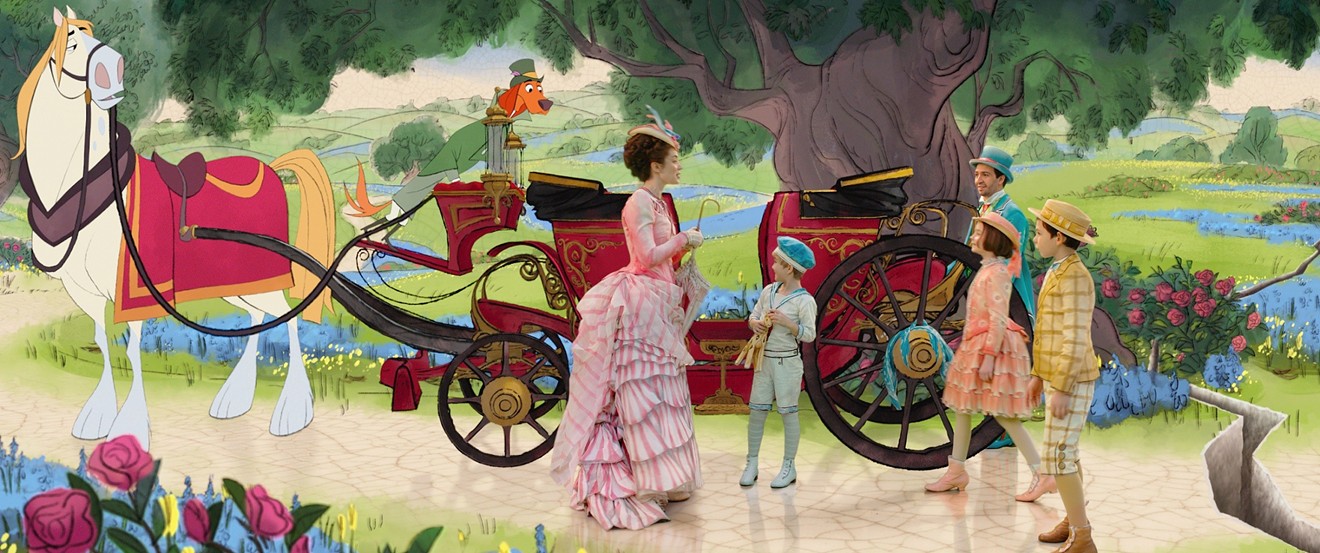True to the spirit of the chipper, somewhat aimless live-action Disney day killers that inspired it, Rob Marshall’s Mary Poppins Returns gets better the further it wanders from its actual story. The plot concerns a greedy banker (Colin Firth), a missing deed and a potential foreclosure on the rambling London home of widower Michael Banks (Ben Whishaw) and his kids. Would it surprise you to learn that keeping the house depends upon Michael getting the missing paperwork to the banker’s desk before Big Ben tolls midnight? Or that the glum, overworked dad has to relearn everything he knew as a kid about the power of the imagination?
The filmmakers expel exhausting energy in their attempts to heat up such burnt-out chestnuts. The good news, though, is that they, on occasion, set the story aside and invite us simply to hang out with the kids, a chip-chip lamplighter played by Lin-Manuel Miranda and, above all else, Emily Blunt’s Mary Poppins. She’s a crisply officious wonderment of a nanny who brooks no sass or silliness — and, when the adults aren’t looking, magics up the place like a ninth-level conjurer. Blunt’s Poppins is no imitation of Julie Andrews. She has a chillier mien, a more pronounced sense of annoyance about her and, at the edges of some scenes, Blunt suggests the secret inner life of this brilliant sorceress who, for some unstated reason, devotes her talents to bathing and teaching some random family. Whishaw’s Michael Banks is the grown-up version of one of the kids from the original Mary Poppins, and this Poppins seems just the slightest touch cross that she’s called upon to straighten out this clan again.
At its best, this update slows down and wallows in gentle enchantment. The best stretch is a stroll across the surface of a porcelain vase the kids have cracked. The film is set in the 1930s, but the vase has emblazoned on it a carriage from a couple of decades earlier; once Poppins has twinkled the kids into that little scene, they amble along, accompanied by old-fashioned 2D cartoon animals, to a turn-of-the-century music hall, where Miranda’s lamplighter and Blunt’s Poppins both dazzle with riotous patter songs. (Poppins, hilariously, at first demurs when asked to sing — she couldn’t possibly — and then with almost no prompting, vaults to the stage and brings the house down.) The songs, I fear, don’t compare with “Chim Chim Cher-ee,” but the leads invest them with consummate cheer. Marshall, for his part, doesn’t cut away as often as he has tended to in his earlier musicals (Chicago, Nine, Into the Woods), trusting Blunt and Miranda to wow us with their actual performances. Even as the inevitable animated penguins waddle out for a soft-shoe number, Marshall keeps the focus on his stars.
Other highlights include: Whishaw talk-singing through a paean to Michael’s late wife; a tender lullaby Blunt croons to a kid; an underplayed romance between Miranda’s character and a labor activist (!) played by Emily Mortimer (!); a whoopingly weird gravity-bender of a number performed by Meryl Streep; and a giddy third-act showstopper featuring dozens of lamplighter boys dancing Newsies-style and performing bicycle tricks. The highs are delirious, especially when Blunt is singing. Those spoonfuls of sugar help the plotty, predictable lows go down.
[
{
"name": "Air - MediumRectangle - Inline Content - Mobile Display Size",
"component": "19274298",
"insertPoint": "2",
"requiredCountToDisplay": "2"
},{
"name": "Editor Picks",
"component": "17482312",
"insertPoint": "4",
"requiredCountToDisplay": "1"
},{
"name": "Inline Links",
"component": "18711090",
"insertPoint": "8th",
"startingPoint": 8,
"requiredCountToDisplay": "7",
"maxInsertions": 25
},{
"name": "Air - MediumRectangle - Combo - Inline Content",
"component": "17482310",
"insertPoint": "8th",
"startingPoint": 8,
"requiredCountToDisplay": "7",
"maxInsertions": 25
},{
"name": "Inline Links",
"component": "18711090",
"insertPoint": "8th",
"startingPoint": 12,
"requiredCountToDisplay": "11",
"maxInsertions": 25
},{
"name": "Air - Leaderboard Tower - Combo - Inline Content",
"component": "17482313",
"insertPoint": "8th",
"startingPoint": 12,
"requiredCountToDisplay": "11",
"maxInsertions": 25
}
]












